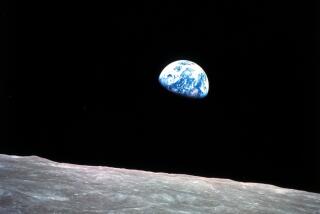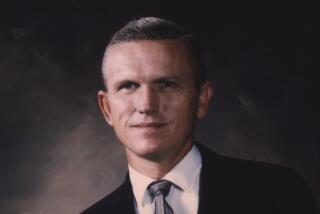Rocket Booster : Moon Astronaut Urges Renewed Space Exploration
- Share via
Speaking in Simi Valley Tuesday, the last man to leave his footprints on the moon called for a renewed emphasis on space exploration as a way to advance technology.
“We need to develop a national public awareness” of the benefits of space research, said former astronaut Eugene A. Cernan, who walked on the moon as part of Apollo 17’s December, 1972, voyage--mankind’s last lunar trip. “The space program has done a very poor job . . . of developing an identity.”
Addressing more than 300 people at the Ronald Reagan Presidential Library and Museum, Cernan said that discoveries yet to be made in space will further technology, thereby working indirectly to solve problems such as homelessness, cancer, AIDS and heart disease.
The silver-haired, 60-year-old Cernan, who now lives in Houston, Tex., came to the library in commemoration of last week’s 25th anniversary of the first moon walk.
In a 40-minute speech, he recounted in detail his own 12-day voyage to the moon with fellow astronauts Ronald E. Evans and Harrison H. Schmitt. Then, still standing on the library’s auditorium stage, Cernan took questions from would-be future astronauts.
“Were you afraid?” asked John Fatollahi, 7, of Newbury Park.
“Maybe my heart was beating a little fast,” Cernan admitted. “But I was glad to be there.”
The boy also wondered what would happen if the Earth was struck by a comet like the one that just hit Jupiter.
“I think that we would look at the earthquake you guys experienced here as a very minor infraction,” the astronaut replied.
A priest from Santa Barbara wanted to know whether the moon landing made Cernan want to talk with God.
“I was inspired. I was convinced that there is a God,” Cernan responded.
The priest, Father Antonio Cacciapuoti of St. Raphael Church, said later that he has always been fascinated by astronauts. As a boy in 1969 in Naples, Italy, he recalled, he left a soccer game to run home and watch the first Americans walking on the moon.
Space fan Mike Bliss, 51, of Simi Valley, confessed that he harbored doubts about whether man actually had walked on the moon. He asked Cernan why photographs of the moon show different colors on the lunar surface.
His skepticism was somewhat diminished, he said, by Cernan’s explanation: “On the moon you do see shades of gray,” Cernan said, adding that solar radiation causes changes in color.
Five-year-old Sam Rosenblum of Thousand Oaks stole the show with his question about how one goes to the bathroom in space.
An amused Cernan--who said he had been asked the same question countless times--told the boy that urine is dispensed into space, where it turns to ice crystals. Solid waste is kept in bags that are stored in a pressurized compartment “because for some reason doctors want to look at it.”
The ideas of today’s children will determine the direction of the space program in coming decades, Cernan said.
More to Read
Sign up for Essential California
The most important California stories and recommendations in your inbox every morning.
You may occasionally receive promotional content from the Los Angeles Times.













